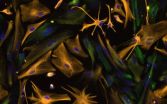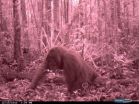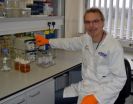(Press-News.org) For nearly a decade, Northwestern University and the Art Institute of Chicago have been partners in conservation science, unlocking secrets about many of the museum's masterpieces -- by Pierre-Auguste Renoir, Pablo Picasso, Henri Matisse, Winslow Homer, George Seurat, Mary Cassatt and others -- and developing new methods and technologies to investigate art.
Last year, a $2.5 million grant from the Andrew W. Mellon Foundation established the Northwestern University/Art Institute of Chicago Center for Scientific Studies in the Arts (NU-ACCESS), a new national model of interdisciplinary scientific research in the arts. (More about the center and past projects: http://www.northwestern.edu/newscenter/stories/2013/01/northwestern-art-institute-partnership-expands-with-mellon-grant.html)
The center recently announced its first two conservation science collaborations: with the Solomon R. Guggenheim Museum in New York City to study works by Laszlo Moholy-Nagy and with the Smart Museum at the University of Chicago to study an important group of 20th-century bronze sculptures.
Showcasing the types of problems that can benefit from the approach espoused by NU-ACCESS, scientists Richard Van Duyne and Katherine Faber of Northwestern and Francesca Casadio of the Art Institute will be participating in press briefings and symposia Feb. 13 and 14 at the American Association for the Advancement of Science (AAAS) annual meeting in Chicago. (Faber and Casadio are co-directors of NU-ACCESS.)
Also, just a few blocks to the south of the AAAS meeting, the Art Institute has a first-of-its-kind exhibition presenting an in-depth look at Renoir's painting process and the scientific detective work used to unlock its mysteries. The study conducted by Northwestern and Art Institute scientists of a brilliant red pigment that has faded in Renoir's oil painting "Madame Léon Clapisson" is the cornerstone of the exhibition (Feb. 12 through April 27).
"Paintings: At and Under the Surface" (press briefing)
(10 a.m. CST Thursday, Feb. 13, Vevey Room 3, Swissôtel Chicago)
Northwestern chemist Richard Van Duyne will speak about his work identifying organic colorants in Renoir's oil painting "Madame Léon Clapisson," Winslow Homer's watercolor "For to be a Farmer's Boy" and Mary Cassatt's pastel "Sketch of Margaret Sloane, Looking Right." Van Duyne will be available for questions.
Katherine Faber (Northwestern) and Francesca Casadio (Art Institute of Chicago) will be available for questions on the specific projects and techniques of the Northwestern-Art Institute partnership, but they are not scheduled speakers at the briefing.
"Detecting Organic Dyestuffs in Art with Surface-Enhanced Raman Spectroscopy" (presentation)
(10 to 11:30 a.m. CST Friday, Feb. 14, Acapulco, Hyatt Regency Chicago)
As part of the symposium "Preserving Our Cultural Heritage: Science in the Service of Art," Northwestern chemist Richard Van Duyne will speak about his work identifying organic colorants in Renoir's oil painting "Madame Léon Clapisson," Winslow Homer's watercolor "For to be a Farmer's Boy" and Mary Cassatt's pastel "Sketch of Margaret Sloane, Looking Right." Van Duyne used a powerful technique called surface-enhanced Raman spectroscopy (SERS), which he discovered in 1977, to uncover details of these works of art.
"Reconstructing and Deconstructing Paintings: Innovations At and Below the Surface" (symposium)
(1 to 2:30 p.m. CST Friday, Feb. 14, Grand Ballroom A, Hyatt Regency Chicago)
The symposium is co-organized by Northwestern's Katherine Faber and the Art Institute's Francesca Casadio and will be moderated by Martha Tedeschi, deputy director for art and research at the Art Institute. The symposium will focus on three specific projects in which advances in analytical and imaging probes have afforded an unprecedented view of complex materials in paintings by Pablo Picasso, Mark Rothko and some of the Old Masters.
"Renoir's True Colors: Science Solves a Mystery" (art exhibition)
(Feb. 12 through April 27, gallery 226, Art Institute of Chicago, 111 S. Michigan Ave., Chicago)
This special display offers an in-depth -- and truly 360-degree -- view of both Renoir's process of painting the Impressionist masterpiece "Madame Léon Clapisson" and the high-tech methods used by Art Institute and Northwestern "detectives" to uncover new information. Their investigation led to discovering that Renoir used carmine lake, a brilliant but light-sensitive red pigment, in this colorful oil painting. The Art Institute's conservation department produced a new digital visualization of the painting's original colors. This re-colorized reproduction and the original painting can be viewed side by side, with the original presented in a case that offers 360-degree views. More information is available at http://www.artic.edu/exhibition/renoir-s-true-colors-science-solves-mystery.
INFORMATION: END
Conservation science partnership thrives, expands
Center for scientific research in the arts collaborating with Guggenheim, Smart Museum
2014-02-13
ELSE PRESS RELEASES FROM THIS DATE:
Protein switch dictates cellular fate: stem cell or neuron
2014-02-13
Researchers at the University of California, San Diego School of Medicine have discovered that a well-known protein has a new function: It acts in a biological circuit to determine whether an immature neural cell remains in a stem-like state or proceeds to become a functional neuron.
The findings, published in the February 13 online issue of Cell Reports, more fully illuminate a fundamental but still poorly understood cellular act – and may have significant implications for future development of new therapies for specific neurological disorders, including autism and ...
Marriage's 'haves' and 'have nots'
2014-02-13
EVANSTON, Ill. --- Today Americans are looking to their marriages to fulfill different goals than in the past — and although the fulfillment of these goals requires especially large investments of time and energy in the marital relationship, on average Americans are actually making smaller investments in their marital relationship than in the past, according to new research from Northwestern University.
Those conflicting realities don't bode well for the majority of marriages, according to Eli Finkel, professor of psychology in the Weinberg College of Arts and sciences ...
Why did the orangutan come down from the trees?
2014-02-13
Orang-utans come down from the trees and spend more time on the ground than previously realised – but this behaviour may be partly influenced by man, a new study has found.
Dr Mark Harrison, based in the Department of Geography at the University of Leicester and Managing Director of the Orang-utan Tropical Peatland Project (OuTrop) has, along with international colleagues, published results of a seven year study of orang-utans in Borneo in the journal Scientific Reports.
The research, conducted between June 2006 and March 2013, is based on a large-scale analysis of ...
Plants recycle too
2014-02-13
Cells communicate through proteins embedded in their cell membranes. These proteins have diverse functions and can be compared with antennas, switches and gates. For the well-being of the cell, it has to adjust the composition of its membrane proteins and lipids constantly. New proteins are incorporated, while old proteins get recycled or eliminated. The process by which membrane material gets internalized is called endocytosis. A research team headed by Daniël van Damme and Geert De Jaeger from VIB and Ghent University (Belgium), and Staffan Persson from the Max Planck ...
How bacteria communicate with us to build a special relationship
2014-02-13
Communication is vital to any successful relationship. Researchers from the Institute of Food Research and the University of East Anglia have discovered how the beneficial bacteria in our guts communicate with our own cells.
This is a key step in understanding how our bodies maintain a close relationship with the population of gut bacteria that plays crucial roles in maintaining our health, fighting infection and digesting our food.
A study, published in the journal Cell Reports, shows that the gut bacteria produce an enzyme that modifies signalling in cells lining the ...
Broad, MIT researchers reveal structure of key CRISPR complex
2014-02-13
Researchers from the Broad Institute and MIT have teamed up with colleagues from the University of Tokyo to form the first high definition picture of the Cas9 complex – a key part of the CRISPR-Cas system used by scientists as a genome-editing tool to silence genes and probe the biology of cells. Their findings, which are reported this week in Cell, are expected to help researchers refine and further engineer the tool to accelerate genomic research and bring the technology closer to use in the treatment of human genetic disease.
First discovered in bacteria in 1987, CRISPRs ...
Treating stroke with IV magnesium within an hour of symptoms fails to improve outcomes
2014-02-13
In the first study of its kind, a consortium led by UCLA physicians found that giving stroke patients intravenous magnesium within an hour of symptom onset does not improve stroke outcomes, according to research presented today at the American Stroke Association's International Stroke Conference.
However, the eight-year study found that, by working with paramedics in the field, intravenous medications can be given to stroke patients within the "golden hour," the window in which patients have the best chance to survive and avoid debilitating, long-term neurological damage. ...
Vitamin B12 accelerates worm development
2014-02-13
WORCESTER, MA – Everyday our cells take in nutrients from food and convert them into the building blocks that make life possible. However, it has been challenging to pinpoint exactly how a single nutrient or vitamin changes gene expression and physiology. Scientists at the University of Massachusetts Medical School have developed a novel interspecies model system that allows these questions to be answered. In a study appearing in the journal Cell, UMMS researchers use this new approach to show how bacterially supplied vitamin B12 changes gene expression, development and ...
Data links quick fix
2014-02-13
Software that can fix 90 percent of broken links in the web of data, assuming the resources are still on the site's server, has been developed by researchers in Iran. The details are reported this month in the International Journal Web Engineering and Technology.
Everyone knows the frustration of following a link to an interesting web site only to discover the target page is no longer there and to be presented with an error page. However, more frustrating and with wider implications for science, healthcare, industry and other areas is when machines communicate and expect ...
UEF study: Metabolic syndrome is similar in different age groups
2014-02-13
Metabolic risk factors cluster similarly in children and adults, according to a study carried
out at the University of Eastern Finland. Furthermore, in adults, the clustering of these risk
factors increases the risk of premature death caused by type 2 diabetes, myocardial infarction
and cardiovascular diseases. The results indicate that lifestyle interventions aiming at the
prevention of type 2 diabetes and cardiovascular diseases should be invested in already in
childhood. The results of the study were recently published in Diabetologia.
Metabolic
syndrome ...
LAST 30 PRESS RELEASES:
University of Oklahoma researcher awarded funding to pursue AI-powered material design
Exploring how the visual system recovers following injury
Support for parents with infants at pediatric check-ups leads to better reading and math skills in elementary school
Kids’ behavioral health is a growing share of family health costs
Day & night: Cancer disrupts the brain’s natural rhythm
COVID-19 vaccination significantly reduces risk to pregnant women and baby
The role of vaccination in maternal and perinatal outcomes associated with COVID-19 in pregnancy
Mayo Clinic smartwatch system helps parents shorten and defuse children's severe tantrums early
Behavioral health spending spikes to 40% of all children’s health expenditures, nearly doubling in a decade
Digital cognitive behavioral treatment for generalized anxiety disorder
Expenditures for pediatric behavioral health care over time and estimated family financial burden
Air conditioning in nursing homes and mortality during extreme heat
The Alps to lose a record number of glaciers in the next decade
What makes a good proton conductor?
New science reporting guide published for journalists in Bulgaria
New international study reveals major survival gaps among children with cancer
New science reporting guide published for journalists in Turkey
Scientists develop a smarter mRNA therapy that knows which cells to target
Neuroanatomy-informed brain–machine hybrid intelligence for robust acoustic target detection
Eight SwRI hydrogen projects funded by ENERGYWERX
The Lundquist Institute and its start-up company Vitalex Biosciences Announces Strategic Advancement of Second-Generation fungal Vaccine VXV-01 through Phase 1 Trials under $40 Million Competitive Con
Fine particles in pollution are associated with early signs of autoimmune disease
Review article | Towards a Global Ground-Based Earth Observatory (GGBEO): Leveraging existing systems and networks
Penn and UMich create world’s smallest programmable, autonomous robots
Cleveland researchers launch first major study to address ‘hidden performance killer’ in athletes
To connect across politics, try saying what you oppose
Modulating key interaction prevents virus from entering cells
Project explores barriers to NHS career progression facing international medical graduates
Jeonbuk National University researchers explore the impact of different seasonings on the flavor perception of Doenjang soup
Two Keck Medicine of USC Hospitals named Leapfrog Top Teaching Hospitals
[Press-News.org] Conservation science partnership thrives, expandsCenter for scientific research in the arts collaborating with Guggenheim, Smart Museum



